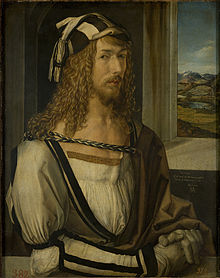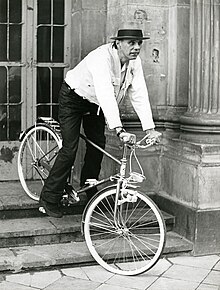Self-presentation
Self-expression is the way in which a self , an I , a person , a social group or an institution presents itself to others. Typical means of expression for self-portrayal are the form of language, non-verbal behavior (body language) as well as immediate or medially conveyed aesthetic appearance. The term is used in the fields of sociology , biology , art , literature , social psychology and marketing . A staging strategy to create a certain reputation with others. The aim of the staging: a desired self with the essential function of increasing social influence. Hence, individuals in social interactions direct, influence and control the impression they make on other people. Typical media for self-presentation are the content of statements, as well as non-verbal behavior and appearance.
Semantics of the term
Self-portrayal is a combination of words from self , the term for “the self-conscious self” and from portrayal , the term for “shaping a role on the stage”.
Origin of the term
In terms of content, the term can be traced back to the Canadian-American sociologist Erving Goffman , one of "the most influential sociologists of the twentieth century", whose 1956 work is called The Presentation of Self in Everyday Life and was published in German under the title We all play theater , which was accepted by the author is. The “Present of Self” in the original was matched in the German translation with the word combination self-presentation . It became naturalized from then on.
In sociology
So the term found its way into the scientific discourse in Germany. Goffman starts from the assumption that as soon as a person presents himself to other people - practices self-expression - has an existential interest in controlling the impression he gives off as much as possible. For a better understanding of his theoretical concept, Goffman uses the metaphor “theater”, but sees the difference between stage and life as significant: “Things are simulated on the stage. In life, on the other hand, things are most likely presented that are real, but have only been insufficiently tested. ”Self-presentation is therefore not, as it has so often been and still is, the conscious pretense of false facts, but a habitus for“ maintaining expressive identifiability “Which a person succeeds sometimes better, sometimes less well and depends on repeated 'rehearsals'.
In biology
At least since the 1970s, self-expression to the central concept in the philosophical biology and anthropology of Adolf Portmann become. He understands by it the (value-neutral) self-expression of the “inwardness” of living beings, more precisely the “expression of an inner being of the organism”. For Portmann, self-portrayal is the central motif of lively formation and stands for the fact that "a living being, animal or plant, not only drives metabolism and can be explained as a structure of life-sustaining structures, but that the organism goes beyond the mere deadline of the Beyond all that is necessary, builds up a form that represents what is special of this kind. "
In literature and art
While terms such as self-confidence and self-knowledge refer to internal, cognitive and creative processes of a person, the word combination self-portrayal refers to staging oneself outwardly through media means of expression and their design : in the medium of autobiography and self-portrait . A decisive event for the public recognition of the term as a serious category was the self-presentation series organized by Wulf Herzogenrath in the Kunstring Folkwang in 1971, in which fourteen artists as diverse as Joseph Beuys , HAP Grieshaber , Hans Haacke , Erwin Heerich , Alfred Hrdlicka , Heinz Mack , Frei Otto , Otto Piene , Karlheinz Stockhausen , Günther Uecker , Timm Ulrichs , Konrad Wachsmann , Stefan Wewerka and Ludwig Wilding took part. The series began on April 14, 1971 with Günther Uecker and ended on December 6, 1972 with Timm Ulrichs . All "artists were free to choose the form of self-expression ." While Karlheinz Stockhausen, for example , played and commented on parts from his work Klänge on tape, Joseph Beuys , supported by slide projections of some of his most important works, performed self-expression in the form of free speech, by answering specific questions, sometimes more briefly, sometimes more extravagantly. Among the artists, it was Beuys and Andy Warhol above all others who “[stylized] themselves into icons, idols, gurus and brands: skilfully staged ego shows in the beginning media age”.
In social psychology
In the early 1990s, the term was adopted in social psychology, which in German-speaking science is closely linked to the work of Hans Dieter Mummendey and his psychology of self-expression . He takes up the idea of staging and is based on a staging strategy with which a person seeks to create a certain reputation for himself in other people. The aim of the staging is a "desired self" with the essential function of increasing social influence and steering, influencing and controlling the impression made on other people.
In marketing
The fact that the terms self-portrayal and self-portrayal are often used and understood in a disparaging manner is due to impression management , which instrumentalizes Goffman's approach and trims it down to the point of view of salability. The impression on others should be manipulated with the help of various "self-expression tactics". Such approaches are far removed from Goffman's position that the social role of self-expression “not only play well, but also fairly”.
On the Internet
Many users gloss over their profile on social network sites, especially on dating portals, in terms of their age, height and weight, although they say in surveys that their profile is true. As a result, users hope to get more attention from potential partners. The more friends know the profile, the more precise information the user provides.
See also
Web links
Individual evidence
- ↑ Hans Dieter Mummendey : Psychology of self-expression. 2nd, revised and expanded edition. Hogrefe - Publishing House for Psychology, Göttingen u. a. 1995, ISBN 3-8017-0709-1 , p. 111.
- ↑ Duden: German Universal Dictionary . 5th, revised edition, Mannheim / Leipzig / Vienna / Zurich 2003, p. 1438
- ↑ Duden: German Universal Dictionary . 5th, revised edition, Mannheim / Leipzig / Vienna / Zurich 2003, p. 353
- ^ Philip Manning on Erving Goffman (2003, p. 34).
- ↑ Erving Goffman: We all play theater. Self-portrayal in everyday life , Munich 1959.
- ↑ Goffman 1956, p. 17.
- ↑ Erving Goffman: We all play theater. Self-portrayal in everyday life , Munich 1959, p. 3.
- ^ (Maintenance of expressive identifiability) - Erving Goffman: Frame Analysis. New York 1974, p. 288.
- ^ Adolf Portmann: At the limits of knowledge. From the contribution of biology to a new worldview. Vienna u. a. 1974, ISBN 3-430-17599-2 , p. 138.
- ^ Adolf Portmann: At the limits of knowledge. From the contribution of biology to a new worldview . Vienna u. a. 1974, ISBN 3-430-17599-2 , p. 138.
- ↑ Vincent Kaufmann / Ulrich Schmid / Dieter Thomä (eds.): The public I. Self-portrayals in a literary and media context . Bielefeld 2014, p. 15 ff.
- ↑ http://www.kunstring-folkwang.de/de/kontakt/geschichte/chronik.html
- ↑ Wulf Herzogenrath (Ed.): Self-presentation. Artist about themselves . Droste Verlag Dusseldorf 1973, p 11-12, ISBN 3 7700 0339 X .
- ↑ Wulf Herzogenrath (Ed.): Self-presentation. Artist about themselves . Droste Verlag Dusseldorf 1973, p 11-12, ISBN 3 7700 0339 X .
- ↑ Christina Tilmann: “Laughter promotes the revolution”, in: Neue Zürcher Zeitung , June 2, 2017, p. 23.
- ↑ Hans D. Mummendey with the collaboration of Stefanie Eifler / Werner Melcher: Psychology of Self-Presentation , 2nd, revised and expanded edition. Göttingen 1995, ISBN 3-8017-0709-1 , p. 111 ff.
- ↑ M. Weißhaupt: Impression Management , in: Attitude interviews: Effects of different self-portrayal tactics on the perception and assessment of people , Tübingen 1997, p. 38 ff .; Cristián Gálvez : You are what you show! Success through self-presentation. (Enthusiastic, motivating, convincing) , Munich 2007. ISBN 978-3-426-78040-4 .
- ↑ Hans-Georg Soeffner: Keyword Erving Goffman , in: Metzler Philosophen Lexikon. From the pre-Socratics to the new philosophers . 2. updated and exp. Ed., Stuttgart / Weimar 1995, ISBN 3-476-01332-4 , p. 321.
- ↑ Sabina Trepte, Leonard Reinecke: Medienpsychologie . 1st edition. Kohlhammer, October 31, 2012, p. 176-178 .



